Share
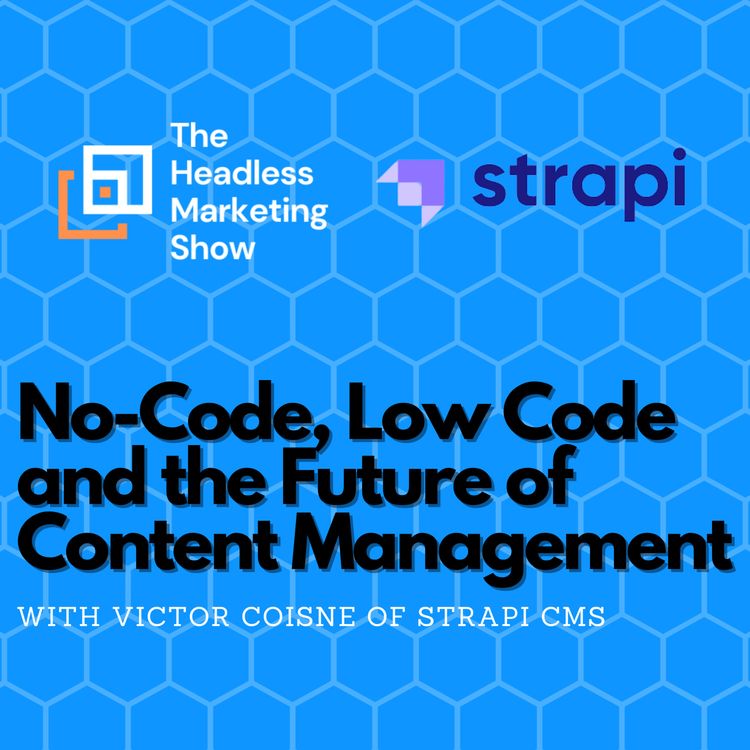
The Headless Marketing Show
No-Code, Low Code and the Future of Content Management
Today on the show we have Victor Coisne the VP of Marketing at Strapi CMS. Strapi is an open-source headless CMS that we’ve used a number of times here at WebriQ. Today Victor and I talk all about the rise of no-code/low-code tools for the marketing world
No-code is immensely popular right now. Tools like Webflow, Squarespace, Wix, and on and on. It seems every week there’s a new drag and drop editor available on the market. But for all the popularity many companies end up using better tools like a CMS or Content Management System because of the benefits they provide.
We sat down to discuss what no-code and low-code look like for marketers today and to measure their pros and cons and discuss why plenty of marketing teams opt for a CMS. Victor had some great insight on why a headless CMS may be a great middle-ground for marketing teams capable of using a low-code tool while also needing the benefits that headless cms can provide.
If you have been thinking about how to manage your digital experiences and considering a no-code tool versus WordPress or thinking about adding a grouping of plugins to WordPress to make it as no-code as possible Victor has some great commentary I am sure you’ll find valuable. If you find yourself dealing with some of the limitations of no-code tools or the problems of making WordPress as no-code as possible you may be interested in Low-Code and Headless CMS and Victor provides a great introduction.
As always be sure to check the show notes for more links and information. Enjoy the show!
Strapi is the leading open-source Headless CMS. Strapi gives developers the freedom to use their favorite tools and frameworks while helping editors easily manage their content and distribute it anywhere. The company is based in Paris and San Francisco. To learn more, visit https://strapi.io/
https://www.linkedin.com/in/victorcoisne/
A no-code platform is a programming platform that uses a visual development interface to enable non-technical users to build applications by dragging and dropping software applications to create a full app. Users don't need any previous coding experience to build applications using no-code.
It's key to differentiate between low-code and no-code platforms. Low-code platforms are most often used by individuals with some coding knowledge to achieve a lot more customization and really build what is mission-critical. No-code tools are more limited but easier to use whereas low-code are much more capable of delivering exactly what the business needs it just takes a bit more technical understanding to achieve.
I grabbed a few articles on this subject to help connect a few dots and provide more details on the nature of what we discuss during the show.
Technical debt (also known as design debt or code debt, but can be also related to other technical endeavors) is a concept in software development that reflects the implied cost of additional rework caused by choosing an easy (limited) solution now instead of using a better approach that would take longer.
A headless CMS has no presentation layer and makes content available through APIs. With a headless CMS, the task of the content presentation is performed by an external client consuming APIs exposed by headless CMS.
https://www.webriq.com/monolithic-cms-versus-headless-cms
https://www.webriq.com/headless-content-management-systems-are-rising
We’ve had an entire episode on the topic of headless CMS already, feel free to give it a listen.
More episodes
View all episodes
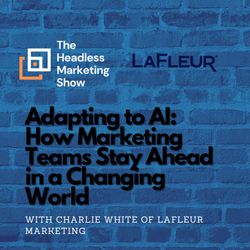
3. Adapting to AI: How Marketing Teams Stay Ahead in a Changing World
53:03||Season 2, Ep. 3In this episode, Alex Belding sits down with Charlie White, Director of Technology at LaFleur Marketing, to explore how marketing agencies adapt to emerging technologies. They discuss LaFleur’s shift from monolithic systems to a headless CMS and the integration of AI tools like GitHub Copilot and Core Insights to improve workflows and enhance marketing analytics. Charlie shares candid insights about managing tech-driven change, balancing innovation with team culture, and how to implement new tools effectively without compromising the human element of work. If you're interested in the intersection of tech, marketing, and change management, this episode is a must-listen!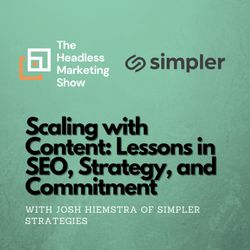
2. Scaling with Content: Lessons in SEO, Strategy, and Commitment
01:01:31||Season 2, Ep. 2In this episode of The Headless Marketing Show, host Alex Belding sits down with Josh from Simpler Strategies to explore the evolving role of content in digital marketing. What started as an SEO tactic has now become the core of successful online strategies, and Josh shares valuable insights on how businesses can develop long-term content plans that drive results. From creating content that resonates with audiences to repurposing it across multiple platforms, this conversation is full of practical advice for anyone looking to improve their digital presence. Whether you’re a small business owner or part of a larger agency, this episode is a must-listen for those serious about mastering content marketing.Tune in to learn how to leverage content for SEO, brand awareness, and sustained business growth!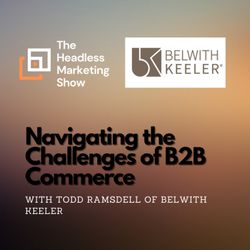
1. Navigating the Challenges of B2B Commerce
40:02||Season 2, Ep. 1In this episode of The Headless Marketing Show, host Alex Belding, co-founder and CRO of WebriQ, sits down with Todd Ramsdell, IT Manager at Belwith Keeler, to explore the intricate journey of deploying a B2B commerce portal. Todd shares firsthand insights into the hurdles of transforming a traditional sales model into a modern digital experience. From overcoming internal resistance and training challenges to enhancing customer interactions and integrating complex backend systems, this episode offers invaluable lessons for businesses considering or refining their B2B commerce strategies. Whether you’re in IT, marketing, or sales, Todd’s experiences provide a roadmap for successfully navigating the complexities of digital transformation. Tune in to discover the key factors that contributed to Belwith Keeler's success in creating a seamless and efficient B2B commerce experience.
14. Compose Your Technology Around Your Business
49:34||Season 1, Ep. 14Compose Your Technology Around Your BusinessGuest: Matt Vendermolen, Vice President of Commerce and Composable at ValtechIntroduction:Welcome to another gripping episode of "The Headless Marketing Show," where we unravel the mysteries of modern marketing strategies and innovations. The Power of Composable Commerce:In this episode, we're joined by digital innovation leader Matt Vendermolen to explore the transformational impact of composable commerce. Delve into the contrasts between composable and traditional monolithic commerce platforms and discover why the former is taking the world by storm.Generative AI in Commerce:Get an insider's look into the groundbreaking implications of generative AI on commerce. Understand how artificial intelligence is shaping the way businesses operate, making them more flexible, responsive, and efficient.Matt's Visionary Statement:"Businesses should build their technology around their business instead of building their business around their technology; this is the power of composable." This profound idea challenges conventional thinking and paves the way for a new era in commerce.Why Listen?Whether you're a marketer, an entrepreneur, or just curious about the future of commerce, this episode is packed with invaluable insights. Tune in to "The Headless Marketing Show" and be part of the conversation that's shaping the future of the industry!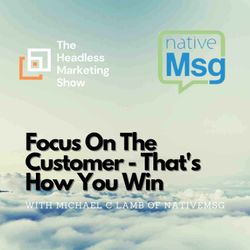
13. Focus On The Customer - That's How You Win
46:31||Season 1, Ep. 13In this episode of The Headless Marketing Show, we are talking about the importance of the Frontend. Our guest Michael C Lamb talks about what he sees a lot of companies miss. They have company experiences and not customer experiences. He sees many firms deploy experiences with all these things put up in front of the user that doesn't bring value to the customer and that causes friction.What is the Frontend?The frontend is anywhere your brand interacts directly with your customers. Social media channels, email, websites, landing pages etc.Michael didn't mince words. Customers don't care about what database you are using, your CRM, or your CMS. None of that stuff matters to them. They care about finding good reliable and valuable information that they need to make good decisions. They care about the experience. Is it easy to work with a brand or is it endless popups and forms and poor content and low-quality experiences? We talked at length about the attention data we should be watching and changing the way we manage our KPIs. Likes, Impressions, page views, and email submissions don't really drive revenue. We should be tracking how customers use the experience. We should be tracking how our frontend is connected to our pipeline and revenue. Using those kinds of KPIs puts a lot more focus on the customer. Focus On The Customer - That's How You WinIn his final piece of advice, Michael summed up the whole episode nicely and we have our title for the show! Enjoy a deeper dive into making better experiences for your customers. Changing your mindset in how you go about setting up experiences and measuring experiences and keeping the frontend the most important element of your experiences.Who Is Michael C. Lamb?Michael C Lamb is the President & Co-founder of nativeMsg, a messaging-first platform supporting emerging and existing messaging, social, and display ad channels making them more effective and robust. By bringing app-like functionality into the text messaging experience, RCS (Rich Communication Services) Messaging takes the outdated "texting" experience making it even more effective and robust. RCS - https://vimeo.com/695835118Conversational Ads eliminate the need for a user to leave the page, keeping their attention while allowing them to interact directly inside the ad unit immersed in your brand. Conversational Ad - https://vimeo.com/600388071The nativeMsg platform enables eCommerce merchants to move their store(s) closer to the consumer - increasing conversions & engagement while capturing valuable zero and first-party data.
12. Why Developers Love Headless CMS
41:02||Season 1, Ep. 12Today on The Headless Marketing Show we are chatting with Jacob Byers about why he loves headless CMS.Jacob was a marketer turned developer when addressing technical issues that companies face when being competitive online. After using several monolithic systems like WordPress, he found that shiny, all-encompassing solutions are not nimble enough to adapt to the ever-changing space that is the web. That was until discovering the Jamstack. Now his business Ohmni is able to use modern technologies that are scalable in nature. Allowing businesses to run their website as part of a larger omnichannel. While giving a cleaner user experience that people expect from the web. We tackle the basic ideas of what the Jamstack and Headles CMS are and how it helps developers and marketers be successful.Other topics of conversation are the issues of technical debt that comes from monoliths like WordPress. Why there can be friction in approaching websites from the Jamstack and the need for digital maturity. All in all this was a fun conversation about headless cms and the reasons to consider using this new approach for marketing and user experience online.Visit with Jacob on LinkedIn or on his website!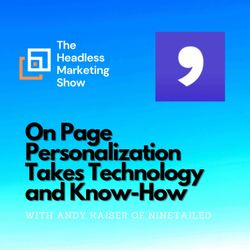
11. On Page Personalization Takes Technology and Know-How
01:00:44||Season 1, Ep. 11I had the pleasure to talk with Andy Kaiser of Ninetailed. Andy is a psychologist, full-stack digital marketer, data native , and entrepreneur. He is well versed in Data Analytics and Digital Strategy as well as E-Commerce and Customer Experience Optimization. With his experience in these areas, he’s set out to make personalization easier to deploy for marketing teams. He founded Ninetailed the first personalization platform for the modern web. In today’s episode, we are discussing all things personalization. Personalization is a big topic. We all know what bad personalization looks like but users are looking for good personalization and marketers want to deliver personalization on their landing pages and other digital experiences in the same way they can now do this in social media. Andy sees two things that marketers need to really get personalization dialed in for their users and their brands. The first is technology. The second is Knowledge. Marketers need the tools in their martech stack to be able to deliver personalized content and experiences wherever their customers are but they also need the knowledge and know-how to deploy personalization to maximum effect. Throughout the episode, we talk about the issues of trying to do personalization on legacy tools and old technologies and the benefits of using modern technologies like headless cms. But also the importance of respecting the end-user and doing personalization in a way that makes the user's experience better - as Andy said, and I am paraphrasing here - "we don’t want to be creepy." If you have been thinking about personalized experiences for your website and other digital experiences this episode is for you!Visit Ninetailed on their website and connect with Andy Kaiser on LinkedIn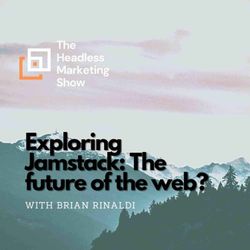
10. Exploring Jamstack: The future of the web?
59:02||Season 1, Ep. 10What is the Jamstack?Here on The Headless Marketing Show we talk a lot about headless CMS and what marketing can benefit from using a headless CMS - these are techy topics and they require a different approach to how you build a website. Enter the Jamstack. On today's show, we'll listen to Brian Rinaldi discuss and explain what the Jamstack is.Simply put the Jamstack is a new way of building and deploying websites and web experiences. It is all about decoupling the website away from monolithic systems and decentralizing the stack with "best in breed microservices" and then re-coupling and pre-building the entire front end.For a lot more details on this feel free to check out these links.Jamstack.org - What is the Jamstack Webriq.com - It is time to drop WordPress and Migrate to the JamstackWhy is the Jamstack important?As we discuss on the show this is a pretty big change to how websites and web experiences are built. In many ways, it is a big update to the systems and procedures many web developers use to build websites and web experiences. For this reason, Jamstack has become immensely popular in development communities. It is easier for developers to build and maintain complex things on the Jamstack than on older server-based tools like WordPress or Drupal and it is much more modern in the way it relates to Javascript and APIs. For marketers, this all matters because the Jamstack makes it much easier to break out of templates and older slower development cycles. It gives WAY more creative control back to the marketing team to be able to build experiences that customers are looking for. In the show, we discuss how older systems come with a lot of constraints and choke-points, and complications that go away when using the Jamstack. Other Jamstack ResourcesBrian Rinaldi offers a great monthly newsletter called Jamstacked - Sign up HERE - while geared towards developers there is a lot of good and interesting information in each newsletter and the level of detail is high. He has also published two books on the subject of Jamstack -both promise to be very beneficial to anyone looking to learn more. Book One - The jamstack BookBook Two - Exploring Jamstack
9. Finding synergy between development and marketing
58:02||Season 1, Ep. 9Today I am excited to introduce Camille Trent, she is the Head of Content at Dooly. Dooly is a sales enablement tool and they market themselves as the fastest way to update Salesforce, take sales notes, and easily manage deals. They aim to help salespeople save 5+ hours of gruntwork/week. Dooly has adopted a headless CMS to manage their content on both their application and their marketing website. In this case, they have chosen Contentful.Today we’ll talk to Camille about what her life is like as a content marketer using a headless CMS and get her opinions on the pros and cons of that kind of architecture. She also talks about the importance of using no-code tools to help her marketing team publish landing pages and non-SEO pages for their campaigns and whenever they need to quickly spin up a new experience.The big question I had for Camille revolves around how the marketing world and developer worlds can become better connected. She had a number of great ideas on how marketing can adopt better tools and run more like an engineering team and or use no-code tools for their testing and experimentation. Camille also talked a lot about empathy and developing a culture of enablement. Creating a workflow where the marketing team is able to work with tools and a process that allows them to be successful while also enabling the development team to use their tools and processes to be successful as well. Both departments ultimately want to see the company succeed and grow and both teams want to do their best work. Allowing that to happen requires finding synergy between marketing and development.Enjoy the show!